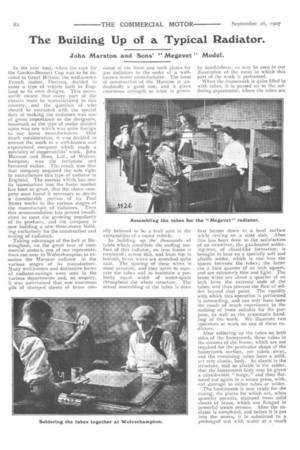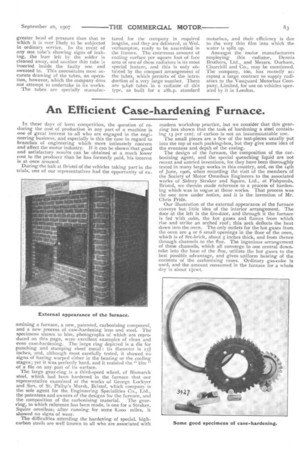The Building Up of a Typical Radiator.
Page 26

Page 27

If you've noticed an error in this article please click here to report it so we can fix it.
John Marston and Sons' " Megevet " Model.
In the year 1903, when the race for the Gordon-Bennett Cup was to be decided in Great Britain, the well-known French maker, Darracq, decided to enter a type of vehicle built in England to its own designs. This necessarily meant that every part of the chassis must be manufactured in this country, and the question of who should be entrusted with the special duty of making the radiators was one of great importance to the designers, inasmuch as the type of cooler decided upon was one which was quite foreign to our home manufacturers. After much consideration, it was decided to entrust the work to a well-known and experienced company which made a speciality of coppersmiths' work. John Marston and Sons, Ltd., of Wolverhampton, was the fortunate and favoured maker. The result was that that company acquired the sole right to manufacture this type of radiator in England. The success which has met its introduction into the home market has been so great, that the above company soon found it necessary to devote a considerable portion of its Paul Street works to the various stages of the manufacture of radiators. Even this accommodation has proved insufficient to meet the growing popularity of its products, and the company is now building a new three-storey buildingexclusively for the construction and testing of radiators.
Taking advantage of the halt at Birmingham, on the great tour of commercial motors, one of our representatives ran over to Wolverhampton to examine the Marston radiator in the various stages of its manufacture. Many well-known and distinctive forms of radiator-casings were seen in the various departments and, on enquiry, it was ascertained that one enormous pile of stamped sheets of brass con
sisted of the front and back plates for soo radiators to the order of a wellknown motor manufacturer. The form of construction of the Marston is undoubtedly a good one, and it gives enormous strength to what is gener ally believed to be a frail unit in the composition of a motor vehicle.
In building up the thousands of tubes which constitute the cooling surface of this radiator, an iron frame is employed; across this, and from top to bottom, brass wires are stretched quite taut. The spacing of these wires is most accurate, and they serve to separate the tubes and to maintain a perfectly equal width of water-space throughout the whole structure. The actual assembling of the tubes is done by hand-tabour, as may be seen in our illustration of the room in which this part of the work is performed.
When the framework is quite filled in with tubes, it is passed on to the soldering department, where the tubes are first beaten down to a level surface while resting on a slate slab. After this has been done to the satisfaction of an examiner, the gas-heated soldering-iron, of chisel-like formation, is brought to bear on a specially soft and pliable solder, which is run into the spaces between the tubes; the latter are a bare quarter of an inch square, and are extremely thin and light. The brass wires are about a quarter of an inch from the extreme ends of the tubes, and thus prevent the flow of solder beyond that point. The rapidity with which this operation is performed is astounding, and can only have been the result of much experiment in the making of irons suitable for the purpose, as well as the systematic handling of the work. We illustrate two operators at work on one of these radiators.
After soldering up the tubes on both sides of the honeycomb, those tubes in the corners of the frame, which are not required for the particular shape of the honeycomb surface, are taken away, and the remaining tubes form a solid, yet very elastic, body. So elastic is the structure, and so pliable is the solder, that the honeycomb body may be given a considerable "bulge," and then flattened out again in a steam press, with out damage to either tubes or solder.
The honeycomb is now ready for the casing, the plates for which are, when quantity permits, stamped from solid sheets of brass, which are flanged in powerful steath presses. After the radiator is completed, and before it is put into the stores, it is submitted to a prolonged test with water at a. much
greater head of pressure than that to which it is ever likely to be subjected in ordinary service. In the event of any one tube's showing signs of leaking, the burr left by the solder is cleaned away, and another thin tube is inserted inside the faulty one and sweated in. This necessitates most accurate drawing of the tubes, an operation, however, which the company does not attempt to undertake in its works.
The tubes are specially manufac
tured for the company in required lengths, and they are delivered, at Wol_ verhampton, ready to be assembled in the frames. The enormous amount ot cooling surface per square foot of face area of one of these radiators is its most special feature, and this is only obtained by the compact arrangement of the tubes, which permits of the introduction of a very large number. There are 9,646 tubes in a radiator of this type, as built for a 2811.p. standard motorbus, and their efficiency is due to the very thin film into which the water is split up.
Amongst the motor manufacturers employing this radiator, Dennis Brothers, Ltd., and Messrs. Durham, Churchill and Co., may be mentioned. The company, too, has recently accepted a large contract to supply radiators to the Vanguard Motorbus Company, Limited, for use on vehicles operated by it in London.




























